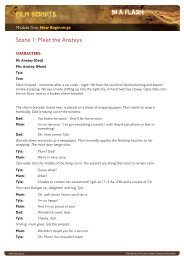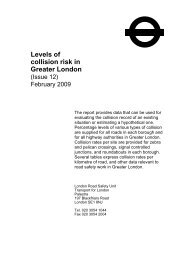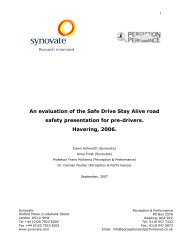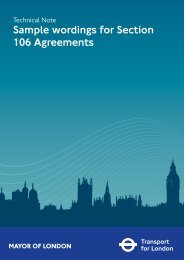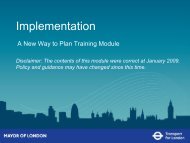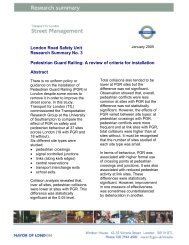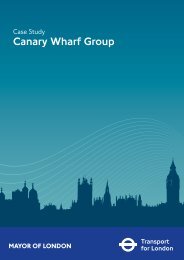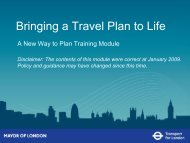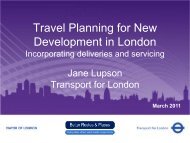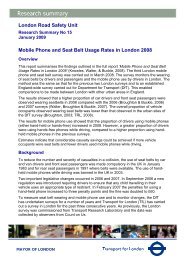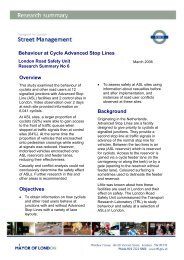Travel Plan contributions to the BREEAM Assessment
Travel Plan contributions to the BREEAM Assessment
Travel Plan contributions to the BREEAM Assessment
Create successful ePaper yourself
Turn your PDF publications into a flip-book with our unique Google optimized e-Paper software.
<strong>Travel</strong> <strong>Plan</strong> <strong>contributions</strong> <strong>to</strong> <strong>the</strong><br />
<strong>BREEAM</strong> <strong>Assessment</strong><br />
A New Way To <strong>Plan</strong> Training Module<br />
Disclaimer: The contents of this module were correct at Oc<strong>to</strong>ber 2009.<br />
Policy and guidance may have changed since this time.
The <strong>BREEAM</strong> <strong>Assessment</strong> 1<br />
• BRE Environmental <strong>Assessment</strong> Method, “<strong>BREEAM</strong>” is <strong>the</strong><br />
most widely used environmental assessment method for<br />
buildings.<br />
• It provides a standard for best practice in sustainable design<br />
• The de fac<strong>to</strong> measure used <strong>to</strong> describe a building's environmental<br />
performance.<br />
• www.breeam.org
The <strong>BREEAM</strong> <strong>Assessment</strong> 2<br />
Aims of <strong>BREEAM</strong><br />
• To mitigate <strong>the</strong> impacts of buildings on <strong>the</strong> environment;<br />
• To enable buildings <strong>to</strong> be recognised according <strong>to</strong> <strong>the</strong>ir<br />
environmental benefits;<br />
• To provide a credible, environmental label for buildings; and<br />
• To stimulate demand for sustainable buildings.
The <strong>BREEAM</strong> <strong>Assessment</strong> 3<br />
• Comprises of a number of schemes including: Education, Retail,<br />
Industrial and Offices<br />
• Credits are awarded for <strong>the</strong> environmental design of <strong>the</strong> building<br />
according <strong>to</strong>:<br />
– Management<br />
– Transport<br />
– Material and Waste<br />
– Pollution<br />
– Health and Wellbeing<br />
– Water<br />
– Land Use and Energy<br />
• Each category consists of a number of issues which seek <strong>to</strong><br />
mitigate <strong>the</strong> impact of a building on <strong>the</strong> environment.
Benefits of <strong>BREEAM</strong><br />
• Promotes <strong>the</strong> environmental credentials and benefits of a building <strong>to</strong><br />
potential purchasers and tenants.<br />
• <strong>BREEAM</strong> provides:<br />
−Market recognition;<br />
−Assurance of best environmental practice;<br />
−Inspiration <strong>to</strong> innovate against environmental Impact;<br />
−Tool <strong>to</strong> reduce running costs, improve environments; and<br />
−Demonstrates progress <strong>to</strong>wards environment and corporate<br />
objectives.
Transport and <strong>the</strong> <strong>BREEAM</strong><br />
<strong>Assessment</strong><br />
• The link <strong>to</strong> sustainability = integration of land-use with transport<br />
planning<br />
• <strong>BREEAM</strong> identified Transportation issues:<br />
– Public transport network connectivity;<br />
– Proximity <strong>to</strong> amenities;<br />
– Cyclist facilities;<br />
– Pedestrian and Cyclist safety;<br />
– Maximum car parking capacity; and <strong>Travel</strong> plans and information.
Case Study:<br />
Office Refurbishment, Swindon<br />
Development Overview:<br />
–Existing office building - 6 s<strong>to</strong>reys;<br />
–Refurbished for continued B1 office use;<br />
–21 on-site car parking spaces;<br />
–Cycle parking provision of 36 spaces (22 spaces required).
Case Study:<br />
Office Refurbishment, Swindon<br />
Development Overview continued:<br />
–Town Centre location;<br />
–Within 100m of <strong>the</strong> central bus station & 200m of <strong>the</strong> rail station; and<br />
–Close <strong>to</strong> local amenities.<br />
–A <strong>Travel</strong> <strong>Plan</strong> was not required as part of a planning obligation.
Components of <strong>the</strong> <strong>Travel</strong> <strong>Plan</strong><br />
Issues demonstrating sustainability<br />
<strong>Assessment</strong> of:<br />
• Existing and future travel patterns;<br />
• Opinions;<br />
• Existing cycle / pedestrian environment;<br />
• Disabled access; and<br />
• Existing public transport links.
Components of <strong>the</strong> <strong>Travel</strong> <strong>Plan</strong><br />
Design Parameters<br />
• Dedicated and covered cycle s<strong>to</strong>rage<br />
• Shower and changing facilities within <strong>the</strong> building;<br />
• Transport information <strong>to</strong> be provided <strong>to</strong> all new employees, available<br />
from communal areas;
Components of <strong>the</strong> <strong>Travel</strong> <strong>Plan</strong><br />
Design Parameters 2<br />
• 4 week introduc<strong>to</strong>ry bus pass with tax free travel <strong>to</strong> follow;<br />
• Promoting <strong>the</strong> available bus links and <strong>the</strong> safe routes <strong>to</strong> / from <strong>the</strong> bus<br />
and rail stations; and<br />
• Linking <strong>the</strong> <strong>Travel</strong> <strong>Plan</strong> with <strong>the</strong> Swindon Workplace Initiative for<br />
Transport (SWIFT).
Benefits of <strong>the</strong> <strong>Travel</strong> <strong>Plan</strong><br />
• The <strong>Travel</strong> <strong>Plan</strong> will:<br />
– Promote alternatives modes;<br />
– Steer building design <strong>to</strong> incorporate pedestrian and cycle facilities;<br />
– Assist with allocating car parking; and<br />
– Subsequently help reduce car use.<br />
• Measures are used <strong>to</strong> steer <strong>the</strong> design of <strong>the</strong> development in order<br />
<strong>to</strong> meet <strong>the</strong> travel plan objectives.
Benefits of <strong>the</strong> <strong>Travel</strong> <strong>Plan</strong> 2<br />
<strong>BREEAM</strong> supports<br />
• Access <strong>to</strong> alternative modes;<br />
• Onsite cycle and pedestrian facilities;<br />
• Low level provision of car parking on site; and<br />
• Reduced CO2 emissions from transport for accessing buildings.
Additional Benefits...<br />
• Contribute <strong>to</strong>wards reducing congestion in <strong>the</strong> wider area;<br />
• Active travel will increase levels of health and well being of staff;<br />
• Deliver environmental objectives;<br />
• Reduce demand for car parking on site;<br />
• Gains accreditation; and<br />
• <strong>BREEAM</strong> can assist with gaining planning agreement for sites in<br />
areas of contention.
Concluding Comments<br />
• Provides evidence that <strong>the</strong> accessibility of <strong>the</strong> site has been<br />
assessed and complies with <strong>BREEAM</strong> criteria.<br />
• Demonstrates long term commitment <strong>to</strong> sustainable travel efforts<br />
and commitment <strong>to</strong> maintaining <strong>BREEAM</strong> standards.<br />
• <strong>Travel</strong> plan helps deliver o<strong>the</strong>r components of <strong>BREEAM</strong>.<br />
• Efforts <strong>to</strong> encourage site access by sustainable travel choices are<br />
visible.
Hotel Developments
Hotel Developments<br />
• Hotel developments in central urban locations are challenged with<br />
design and space issues.<br />
• Main objective: <strong>to</strong> achieve maximum profitability within <strong>the</strong><br />
proposed development area.<br />
• Profitability is gained from <strong>the</strong> hotel and not <strong>the</strong> associated car<br />
parking area.<br />
• Over night stay hotel developments favour reduced car parking<br />
strategies.
<strong>Travel</strong>odge, Basings<strong>to</strong>ke<br />
Implementing <strong>Travel</strong> <strong>Plan</strong>s <strong>to</strong><br />
Reduce <strong>the</strong> need for Car Parking<br />
Development Overview<br />
–137 bed hotel;<br />
–45 car parking spaces (138 required);<br />
–16 Cycle parking spaces;<br />
–Town centre hotel;<br />
–within 100m of bus s<strong>to</strong>p;<br />
–Free car parking facility; and<br />
–Shuttle link <strong>to</strong> <strong>the</strong> Town centre.
Car Parking Requirements &<br />
Hotel Occupancy<br />
• Basings<strong>to</strong>ke and Dean Borough Council Maximum parking<br />
standards :<br />
– 1 car parking space per room = 138 spaces<br />
– apply 50% reduction for accessible locations = 69 spaces<br />
• Occupancy levels<br />
– With 100% occupancy, <strong>the</strong> room occupation by car drivers amounts <strong>to</strong><br />
only 29.4%.<br />
– City centre hotel locations average occupancy, between 70% - 80%.
Car Parking Requirements &<br />
Hotel Occupancy<br />
• Occupancy levels<br />
– With 100% occupancy, <strong>the</strong> room occupation by car drivers amounts <strong>to</strong><br />
only 29.4%.<br />
– City centre hotel locations average occupancy, between 70% - 80%.
Car Parking Requirements &<br />
Hotel Occupancy continued.<br />
• 100% occupancy at 29.4% parking demand = 41 spaces<br />
• Average occupancy level of 80% normal parking demand = 33<br />
spaces<br />
• <strong>Travel</strong> <strong>Plan</strong> <strong>to</strong> promote and encourage sustainable travel<br />
alternatives<br />
• <strong>Travel</strong> <strong>Plan</strong> aims <strong>to</strong> reduce reliance on private car
<strong>Travel</strong> <strong>Plan</strong>s and a Reduced<br />
Car Parking Strategy<br />
• Measures promote and incentivise use of <strong>the</strong> existing travel<br />
options:<br />
– Allocate car parking for staff<br />
– Priority car share spaces<br />
– Car parking management scheme<br />
– Introduc<strong>to</strong>ry bus ticket<br />
– Tax free travel on bus services<br />
– Information pack for staff – continual updating,<br />
– Personal <strong>Travel</strong> <strong>Plan</strong>ning<br />
– Guests provided with information at time of booking<br />
• Cost of <strong>the</strong> <strong>Travel</strong> <strong>Plan</strong> over a 5 year period circa. £7,100
Benefits of <strong>the</strong> <strong>Travel</strong> <strong>Plan</strong><br />
• Measures and Incentives assist in encouraging use of sustainable<br />
travel options.<br />
• Implementing a <strong>Travel</strong> <strong>Plan</strong> provides evidence of <strong>the</strong><br />
developments commitment <strong>to</strong>wards encouraging sustainable<br />
travel choices.<br />
• On average £7,000 profit gained per hotel bedroom in place of<br />
car parking space.
Concluding Comments<br />
• <strong>Travel</strong> <strong>Plan</strong>s coupled with reduced car parking can stimulate<br />
travel behaviour change.<br />
• <strong>Travel</strong> <strong>Plan</strong>s can assist with reducing <strong>the</strong> level of car parking on<br />
site.<br />
• Simple equation that maximising hotel floor area is more<br />
profitable than developing additional car parking area.
Site<br />
Room occupation by car driver at full occupancy levels<br />
No.<br />
Rooms<br />
Observed<br />
proportion<br />
of Guests<br />
as car<br />
driver<br />
Number of<br />
Rooms with<br />
Guests as car<br />
driver at full<br />
occupancy<br />
No of on-site<br />
car parking<br />
spaces<br />
available<br />
Proximity <strong>to</strong><br />
Bus/rail<br />
station<br />
Leeds 100 22% 22 0* 3 mins walk<br />
from Railway<br />
Station<br />
Aberdeen 97 28% 27 28 5 mins walk<br />
from<br />
Railway/Bus<br />
Station
Site<br />
Room occupation by car driver at full occupancy levels<br />
No.<br />
Rooms<br />
Observed<br />
proportion<br />
of Guests<br />
as car<br />
driver<br />
Number of<br />
Rooms with<br />
Guests as<br />
car driver at<br />
full<br />
occupancy<br />
No of on-site<br />
car parking<br />
spaces<br />
available<br />
Proximity <strong>to</strong><br />
Bus/rail<br />
station<br />
Glasgow 95 30% 28 0* 10 mins walk<br />
from Railway<br />
Station<br />
Manchester 162 35% 57 47 £3 Taxi fare<br />
from Railway<br />
Station
Site<br />
Room occupation by car driver at full occupancy levels<br />
No.<br />
Rooms<br />
Observed<br />
proportion<br />
of Guests<br />
as car<br />
driver<br />
Number of<br />
Rooms with<br />
Guests as car<br />
driver at full<br />
occupancy<br />
No of on-site<br />
car parking<br />
spaces<br />
available<br />
Proximity <strong>to</strong><br />
Bus/rail<br />
station<br />
Birmingham 134 29% 39 28 3 mins by<br />
Taxi, 10 min<br />
walk from New<br />
Street Railway<br />
Station
Average Level of Occupancy (year <strong>to</strong> 27/09/2000)<br />
Site<br />
No. of Average Level of<br />
Bedrooms Occupancy<br />
Leeds 100 80.6%<br />
Glasgow 97 81.9%<br />
Aberdeen 95 69.4%<br />
Manchester 162 76.2%<br />
Birmingham 134 76.6%



